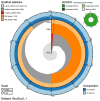Atlantic mackerel population structure does not support genetically distinct spawning components
- PMID: 39524113
- PMCID: PMC11544206
- DOI: 10.12688/openreseurope.17365.2
Atlantic mackerel population structure does not support genetically distinct spawning components
Abstract
Background: The Atlantic mackerel, Scomber scombrus (Linnaeus, 1758) is a commercially valuable migratory pelagic fish inhabiting the northern Atlantic Ocean and the Mediterranean Sea. Given its highly migratory behaviour for feeding and spawning, several studies have been conducted to assess differentiation among spawning components to better define management units, as well as to investigate possible adaptations to comprehend and predict recent range expansion northwards.
Methods: Here, the genome of S. scombrus was sequenced and annotated, as an increasing number of population genetic studies have proven the relevance of reference genomes to investigate genomic markers/regions potentially linked to differences at finer scale. Such reference genome was used to map Restriction-site-associated sequencing (RAD-seq) reads for SNP discovery and genotyping in more than 500 samples distributed along the species range. The resulting genotyping tables have been used to perform connectivity and adaptation analyses.
Results: The assembly of the reference genome for S. scombrus resulted in a genome of 741 Mb. Our population genetic results show that the Atlantic mackerel consist of three previously known genetically isolated units (Northwest Atlantic, Northeast Atlantic, Mediterranean), and provide no evidence for genetically distinct spawning components within the Northwest or Northeast Atlantic.
Conclusions: Therefore, our findings resolved previous uncertainties by confirming the absence of genetically isolated spawning components in each side of the northern Atlantic, thus rejecting homing behaviour and the need to redefine management boundaries in this species. In addition, no further genetic signs of ongoing adaptation were detected in this species.
Keywords: Atlantic mackerel; RAD-seq; complete genome; fisheries management; genome-wide SNPs; population structure.
Plain language summary
The Atlantic mackerel is a commercially valuable migratory pelagic fish inhabiting the northern Atlantic Ocean and the Mediterranean Sea. In both sides of the Atlantic, this species spawns at several locations (spawning components) while migrating north for feeding. It has been hypothesized that the mackerel has a homing behaviour, meaning that they return to spawn to where they were born, in which case, genetic differences should be visible between spawning components. Here, we have sequenced the complete genome of Atlantic mackerel and performed population genetic analyses based on thousands of markers. Our results provide no evidence for genetically distinct spawning components which implies that, for fisheries management, this species should be managed as one unit in each side of the Atlantic.
Copyright: © 2025 Manuzzi A et al.
Conflict of interest statement
No competing interests were disclosed.
Figures


Similar articles
-
Home treatment for mental health problems: a systematic review.Health Technol Assess. 2001;5(15):1-139. doi: 10.3310/hta5150. Health Technol Assess. 2001. PMID: 11532236
-
Signs and symptoms to determine if a patient presenting in primary care or hospital outpatient settings has COVID-19.Cochrane Database Syst Rev. 2022 May 20;5(5):CD013665. doi: 10.1002/14651858.CD013665.pub3. Cochrane Database Syst Rev. 2022. PMID: 35593186 Free PMC article.
-
The Black Book of Psychotropic Dosing and Monitoring.Psychopharmacol Bull. 2024 Jul 8;54(3):8-59. Psychopharmacol Bull. 2024. PMID: 38993656 Free PMC article. Review.
-
Clinical symptoms, signs and tests for identification of impending and current water-loss dehydration in older people.Cochrane Database Syst Rev. 2015 Apr 30;2015(4):CD009647. doi: 10.1002/14651858.CD009647.pub2. Cochrane Database Syst Rev. 2015. PMID: 25924806 Free PMC article.
-
[Volume and health outcomes: evidence from systematic reviews and from evaluation of Italian hospital data].Epidemiol Prev. 2013 Mar-Jun;37(2-3 Suppl 2):1-100. Epidemiol Prev. 2013. PMID: 23851286 Italian.
References
-
- Beckett JS, Stobo WT, Dickson CA: Southwesterly migration of Atlantic mackerel, Scomber scombrus, tagged off Nova Scotia. International Commission for The Northwest Atlantic Fisheries.1974. Reference Source
-
- Bourret A, Smith A, Van Beveren E, et al. : Quantifying genetic differentiation and population assignment between two contingents of Atlantic mackerel ( Scomber scombrus) in the Northwest Atlantic. Can J Fish Aquat Sci. 2023;80(7):1084–1097. 10.1139/cjfas-2022-0232 - DOI
LinkOut - more resources
Full Text Sources
Miscellaneous
